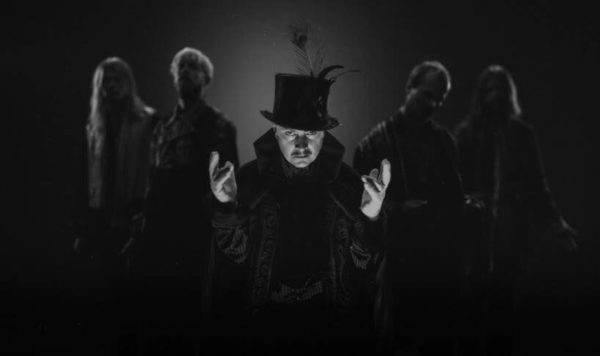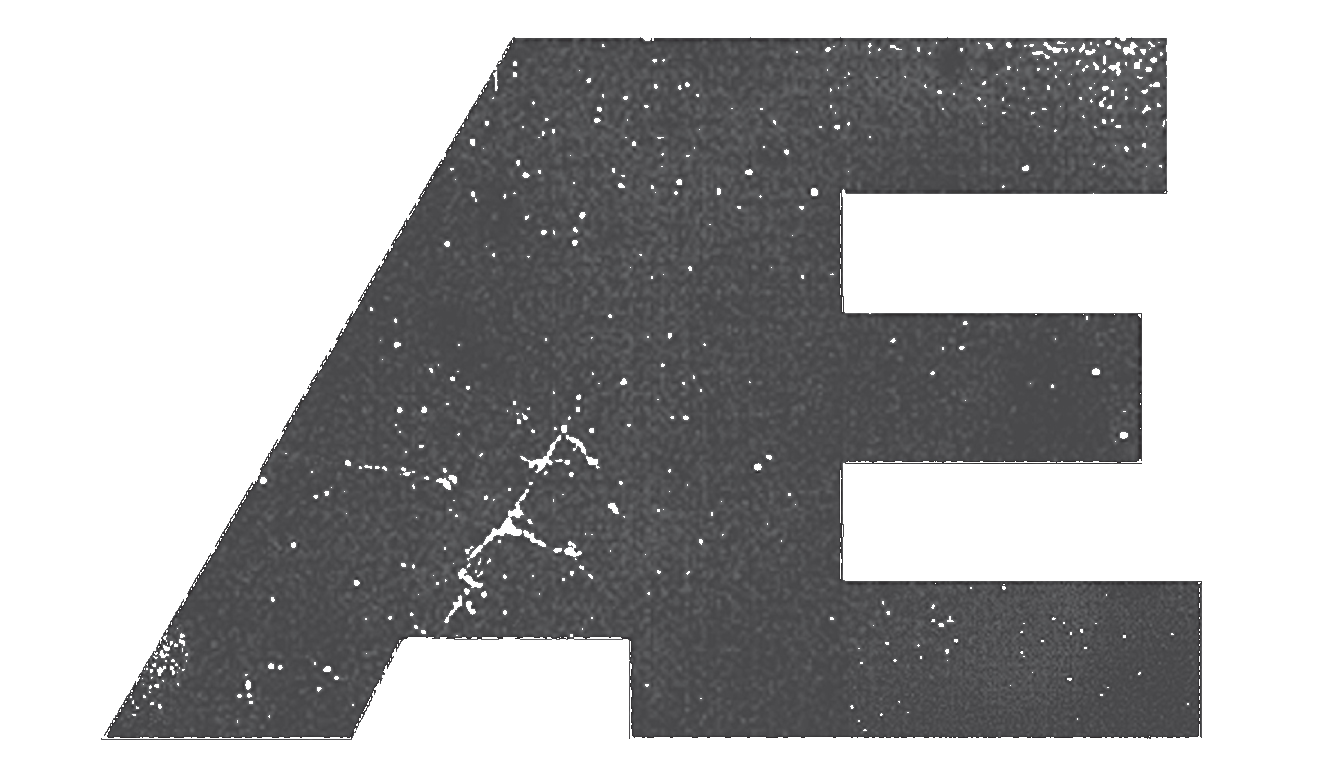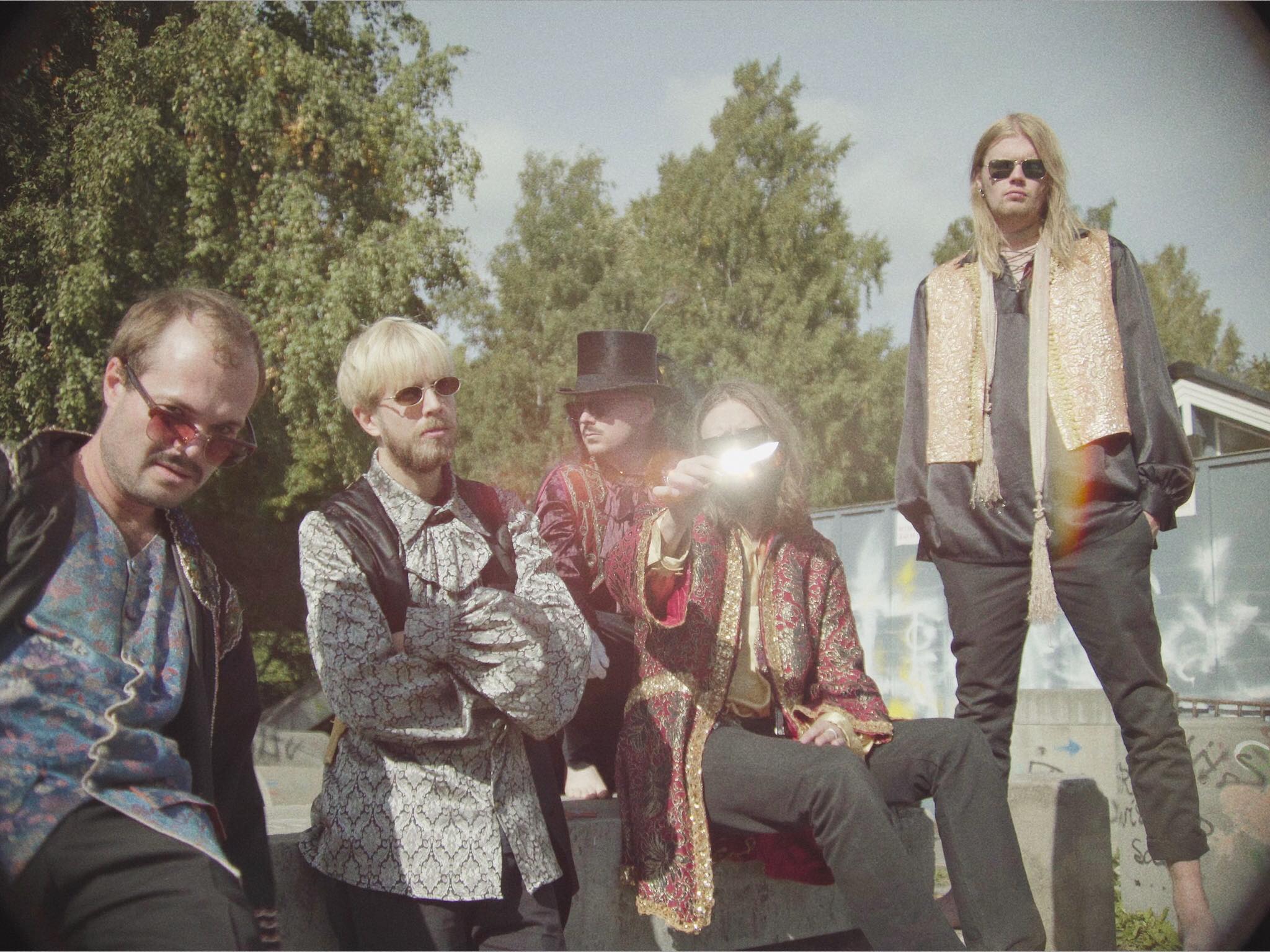Between the burbling of the pots and pans on cooking shows playing in the background of various hubbabubbaklubb recording sessions, there’s one phrase that stuck with the band like a mantra. “It’s something that OP (Ollis Hergum) used to say, and that’s let it simmer” explains Morten Skjæveland, when he and Ollis Hegrum sit down for an interview on frosty evening in October. Let it simmer has since become a “hubba” saying. “We work until it’s done,” Ollis told an impatient Morten time and time again “and if it’s only in ten years time, so be it”. It would be, and even though “it was almost ten years,” in the autumn of 2018 hubbabubbaklubb’s debut LP, drømmen drømmerne drømmer finally arrived into the world.
Like a mature cheese, an aged wine or a braised roast, if you let things simmer long enough, it gives it time to bring those intricate complexities in their fabric to the surface and that has been the ethos that has been the foundation of the hubbabubbaklubb philosophy. “We’ve been talking about this album for so long” says Morten. “You can like it or dislike it, but you have to acknowledge that there are layers there.” drømmen drømmerne drømmer has never been about waiting until “it’s perfect” continues Morten but “more like: let’s see what else shows up.”
Some five years on since they released their first single “Mopedbart” everything that could have been accomplished on a debut LP has been for hubbabubbaklub and as we delve further into the dense haluccianary fabric of hubbabubbaklubb, further than any time we’ve done before, layer upon layer is peeled back till we’re at the big bang moment of it all, where a group of close friends get together for some impromptu art sessions, a band emerges and an album is born.
A time immemorial
The origins of the hubbabubbaklubb are as elusive as their music, but Ollis insists “hubbabubbaklubb as we now know it, didn’t happen until Mopedbart, what happened before then doesn’t really matter.” Mopedbart, which was released in 2012 via Australian record label Death Strobe Records, was the first release that featured the name hubbabubbaklubb, made up at that time of Morten Skjæveland, Ollis Hegrum (Olefonken), Jonas Wasa (Joystick Jay), Pål Rokseth (Gundelach) and André Bratten.
Are you Oslo’s first supergroup?
“Maybe” says Ollis with an expressive burst of laughter, “doing your own stuff, is healthy. ”
All accomplished individual artists, it was on Mopedbart where they all first clicked as a band. Originally, a fast-paced track the only thing that was carried over to its final version was the lyric “Høyfart med Mopedbart,” a lyric that had been knocking about since Ollis’ school days when he and Andre first started making music together. The track was initially recorded on a whim, when the gang went to Pål’s house to pick up some equipment for a recording session.
“We discovered he was home alone,“ says Ollis. “So we were like shouldn’t we just be here instead.” Pål’s “old house in farm country” set the perfect tone for Mopedbart. They were going for a “1979 disco vibe” from the start and the setting “helped with that vibe”. Between “drinking and having fun” André, Pål, Ollis, Jonas and Morten recorded some music.
The result was Mopedbart and an “even older” track called Lille Svøte Svanse which channeled that 1979 Disco vibe into a contemporary stepper with Morten’s abstract nostalgia coursing through the lyrics. On the other side of the record, a funky synth bass and a bouncing beat hops over a the crystal clear, harmonic arrangement of Mopedbart and Morten’s caricature of devil-may-care James Dean cliché on a scooter set an evocative and infectious tone through that song.
Jonas sealed the deal with Andy Webb over at Death Strobe Records after releasing a couple of Disco edits on the sister label, Disco Delicious. Mopedbart became a local and international sensation with Bill Brewster picking up the release early for his DJ History blog and with the track receiving the top honours in the furtive 50 in 2013 selected by the DJ History readers.
The plot thickens
Was Mopedbart ever intended to be an album track?
“I didn’t even think it was going to be a single”, says Ollis hastily. After Mopedbart, and emboldened by the success of the track, they considered ; “next easter let’s do the same, but this time it would be more planned.”
They went back to Pål’s house for the first jamming sessions, and the first track that emerged was an early version of Tommer Lommer which Ollis says “sounds way different to what it sounds like now” on the album. Rumour also has it that a really rough, early version of Et Annet Sted also emerged during this session, but this has been validated. But back to the story. Feeling “more pressured” to deliver a follow up to Mopedbart, and with every member having their own commitments, impromptu jam sessions at Pål’s house wouldn’t suffice. They started taking “hubba vacations: A long weekender where we come together cook some nice food, and do a hubba weekend“ on various retreats to mountain- and seaside cabins around Scandinavia.
This is how the album “came together over the years”, and you can hear echoes of it in the lyrics for Fjellet. “På vei opp till høye fjellet,” sings Morten. “Stjerner lyser opp i mørket. Alene under himmelhvelvet.” Those lyrics came to Morten “in the car on the way up” to his mountain cabin and the mood is perceptible in the quietude of the softly strumming guitar and Morten’s lonesome vocal.
Everything would fall into place when Pål found the band a disused sound room in a film studio called filmparken på Jar. “That’s where we made the bulk of the album,” explains Ollis. It was a space they could call their own, a place where they could just hang out and “see what happens” as Morten puts it.
“We really took our time with it” remembers Ollis and as much as it was a space for hubbabubbaklubb, it was also a place where they could collaborate with other artists, who in turn would make their own invisible imprints on the eventual record.
With the money they “earned from various concerts” they bought a “big mixer” and they were on track to record the rest of an album, but then suddenly, and without warning, they found themselves on the curb, and their hopes dashed at finishing the album.
A slim chance
“We were thrown out of the studio because there was too much drinking and stuff,” recounts Ollis and without the studio, the band were left with a portion of an album and nowhere to record the rest. “That’s really important to understand;” says Morten “it wasn’t a given that this album would see the light of day, there was a 50/50 chance that it was going to manifest itself.”
Ollis recalls when that moment came that they had to leave Jar, “that was the point we thought hubbabubba was dead.”
“That set a damper and it was not the ideal way to go our separate ways.” The band retreated into their individual projects and the album was shelved, but the work they’d done for the album, simmered nonetheless and in Ollis words they thought; “it would be a shame if this didn’t see the light of day”.He turned to the rest band with a proposal: “I told the boys I would like to finish the album but I’m not going to do it for free.” He would take the mixer in payment and it became the “dangling carrot” that he required to finish the album.
The original demo recordings were just that, demos and they were “pretty far off”. Opening up old projects, Ollis had found that some much needed maintenance was required. Pieces of inane conversations coming in and out of recordings where they had forgotten microphones in the room and similar amateur moments, had set him a big task to get the LP done. It required Ollis and the band to “record a lot of stuff”. Pål’s brother, Ole Rokseth was inducted into the band to play bass when André Bratten was committed to his solo project and even the Rokseth patriarch, Stein literally lent a helping hand with some hand percussion. People like Jonas Raabe would be brought into the recording process too and the album turned into something of a family affair for the band.
Over time the tracks matured as pieces came in and arrangements were finalised, but it was a mammoth task taking the original sketches and turning it into the album. “I did my masters degree back… I can’t remember when…” says Morten “and I always said to OP, the album was his master’s degree, but then I handed that shit in and he was still working on the album.” The “life project” finally came together after the best part of a decade.
Morten had floated the title “drømmen drommerne drømmer “at some point early during this process as a shortened version of an Eden Ahbez lyric on the song Full Moon. “It ends with the line dream the dream that dreamers dream. I felt it was really strong and it was really funny to say the same word over and over again.” It’s a song they would come back to a lot during the whole process but only Morten and Ollis knew the title at first. “I was afraid that people would get tired of it,” explains Morten, but yet it still lends an infectious rhythm to the start of the LP that carries through to the music and the artwork.
Unpacking the layers
By the time you reached Den Hvite By, some 9 tracks in an entire world has opened up to the listener. From the familiar singles Tommer Lommer, Mopedbart and Eddie Suzanne, hubbabubbaklubb transport you through the kodak moments of the bands career laid out like the collage on the inner sleeves of the record.
Den Hvite By’s afrocentric qualities mimic Fela Kuti, shoehorning Jonas’ love for the Western African music in to a space-aged Norwegian dialect. “We almost ended up in another world, not afrobeat anymore,” remembers Morten of the recording process and one of the “most magical” moments of the hubbabubbaklubb history.
One of the many snapshots through the career of the hubbabubbaklubb, Den Hvite By forms part of an immense tapestry of music that constitutes drømmen drømmerne drømmer. There’s an undeniable connection to the songs, and whether it creates part of a larger narrative is up to the listener, but it is there to be explored, suggests Morten.
Morten often makes references to the title, especially in the songs Konkylie and Fjellet, but the tracks live beyond the album, as lyrics float around in a dreamscape, untethered to any tangible reality.
There’s a charming nostalgia to hubbabubbaklubb from the music to lyrics but especially the lyrics. Morten has a way of sculpting stories that seem to arrive like an intangible memory, emphasised by his wispy alto bordering on falsetto. His words and voice fall like a shared memory projected from cathode television screen.
In hubbabubbaklub there’s a purpose to all this. “Early on when I started writing lyrics I realised I had to drop all modern references”, says Morten, and that has also helped solidify some kind of symbioses between the lyrics and the music. “When they (the band) dig up old synthesisers and sounds from the past, it’s my duty to humbly mirror that with the choice of words.”
And does the music reflect the lyrics?
“Definitely,” says Ollis and cites Fjellet as an example.
The acoustic guitar track is the furthest they step back from synthesisers and electronic instruments, with a folksy John Denver kind of song about getting back in to nature. It might have been inspired by that epoch in music but it’s not stuck in that era.
Ollis tells me that hubbabubbaklubb would have a track like that and Den Hvite by “lying around for two or three years”, and would often go back to change it, letting it simmer to evolve and grow with the band where at some point it’s reached the best version of itself. “Hopefully that’s the benefit of talking such a long time,” says Ollis “not getting stuck in an era.”
There are influences too, but besides the obvious references to Yellow Submarine, Fela Kuti and Eden Ahbez, Ollis is not willing to divulge anymore of them. Perhaps it would evoke a memory of a listener, but they don’t think it’s the band’s place to imply anything concrete, always getting back to the dream and dreamer.
In a recent interview they were asked who are the dreamers and what are those dreams, and it’s something they’ve been mulling over by the time we get to our interview. It’s “a very vivid picture of younger times and easier times, which for me at least that are what dreams are in a way” says Ollis. For Morten “the dreamers could be young, adventurous people” too striving for that imperceptible perfect version of itself, but ultimately he proffers; “you tell me?”

All the trappings of a timeless classic
So what happens next, how do you follow it up?
“At this point it’s just really nice to see people enjoying it and liking it. Hopefully there will be a couple of vacations,” says Ollis like the weight of the world has just been lifted off his shoulders. Morten is just hoping to ”enjoy this caramel, because it’s been such a long time coming. We are childhood friends and it’s a friendship manifesting itself into this physical thing.”
“That’s the type of guys we were,” continues Morten.” while the other guys came together and watched football, we came together, and we drew. We sat at Wasa’s house and made paintings. Just playing around, with no intention of it becoming a big piece, just the fun of it.” And that philosophy has coursed through the very fibre of hubbabubbaklubb since the beginning and is now physically imprinted on vinyl as drømmen drømmerne drømmer.
Ollis is surprised that he is still able to listen to the album now that it’s out. Usually when he finishes a record “it’s everybody else’s” when it’s done, but on this occasion he keeps coming back to it; that’s until Mopedbart comes on.
“I skip that one” he says and Morten winces at the thought of it. There was some serious discussion in the band about whether that song was going to make it on the album. Morten will at least listen to it, because he likes “to hear (the album) from start to finish with all the transitions”, but it’s a track that divides opinion within the band. in a recent Q&A session with Jonas Wasa he said “I’m so tired of that fucking song,” and Ollis feels he has to defend it. “That doesn’t mean that we don’t like the song” says Ollis, “It’s just form a different era.” It’s still the band’s biggest hit and whenever they play it in a set or live Ollis still finds it “crazy” that “everyone sings along.”
For the listener at least it frames the album perfectly, it’s the glue that holds it all together at the conceptual genesis of it all, forming an integral part of the hubbabubbaklubb narrative that traces a red line through the entire album.
It’s not merely an album of Mopedbart in various other forms but rather an intense and enveloping experience from start to finish that transports you the that ineffable dream that hubbabubbaklubb have succeeded in creating on this album. All that’s left to do in hubbabubbaklubb’s opinion is to “put on some headphones, lean back and dream that dream.”
*drømmen drømmerne drømmer is out now and you can pick up a copy at Filter Musikk.
*Olefonken is back this Friday in is usual residency slot at Frædag invites Âme and Morten will be back at Jæger for Skranglejazz x Frædag presents Gerd Janson and Prins Thomas on the 30th on November.

